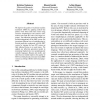Free Online Productivity Tools
i2Speak
i2Symbol
i2OCR
iTex2Img
iWeb2Print
iWeb2Shot
i2Type
iPdf2Split
iPdf2Merge
i2Bopomofo
i2Arabic
i2Style
i2Image
i2PDF
iLatex2Rtf
Sci2ools
ACL
2008
2008
Applying Morphology Generation Models to Machine Translation
We improve the quality of statistical machine translation (SMT) by applying models that predict word forms from their stems using extensive morphological and syntactic information from both the source and target languages. Our inflection generation models are trained independently of the SMT system. We investigate different ways of combining the inflection prediction component with the SMT system by training the base MT system on fully inflected forms or on word stems. We applied our inflection generation models in translating English into two morphologically complex languages, Russian and Arabic, and show that our model improves the quality of SMT over both phrasal and syntax-based SMT systems according to BLEU and human judgements.
ACL 2008 | Computational Linguistics | Inflection Generation Models | Smt Systems | Syntax-based Smt Systems |
| Added | 29 Oct 2010 |
| Updated | 29 Oct 2010 |
| Type | Conference |
| Year | 2008 |
| Where | ACL |
| Authors | Kristina Toutanova, Hisami Suzuki, Achim Ruopp |
Comments (0)

